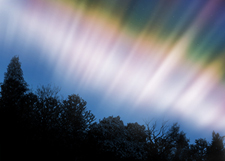Tag: Aurora Borealis
-

Looking at the Northern Lights
The Aurora Borealis—that mysterious shimmer of light appearing sometimes in the night sky—is a great thing to contemplate now during Hanukkah, our Festival of Lights, and so close to the Winter Solstice. You can’t even plan to see the Aurora, this huge, otherworldly phenomenon, one of the strangest of light events…
